- Home
- Diane Ackerman
The Zookeeper's Wife: A War Story
The Zookeeper's Wife: A War Story Read online
The Zookeeper's Wife
Also by DIANE ACKERMAN
An Alchemy of Mind
Cultivating Delight
Origami Bridges
Deep Play
I Praise My Destroyer
A Slender Thread
The Rarest of the Rare
A Natural History of the Senses
A Natural History of Love
Jaguar of Sweet Laughter
Reverse Thunder
On Extended Wings
Lady Faustus
Twilight of the Tenderfoot
Wife of Light
The Planets: A Cosmic Pastoral
FOR CHILDREN
Animal Sense
Monk Seal Hideaway
Bats: Shadows in the Night
ANTHOLOGY
The Book of Love (with Jeanne Mackin)
A WAR STORY
The Zookeeper's Wife
DIANE ACKERMAN
W. W. NORTON & COMPANY
New York London
Copyright © 2007 by Diane Ackerman
All rights reserved
For information about permission to reproduce selections from this book, write to Permissions, W. W. Norton & Company, Inc.,
500 Fifth Avenue, New York, NY 10110
LIBRARY OF CONGRESS
CATALOGUING-IN-PUBLICATION DATA
Ackerman, Diane.
The zookeeper's wife: a war story / Diane Ackerman.—1st ed.
p. cm.
Includes bibliographical references.
ISBN: 978-0-393-06935-8
1. Jews—Poland—Warsaw. 2. Righteous Gentiles in the Holocaust—Poland—Warsaw. 3. Holocaust, Jewish (1939–1945)—Poland—Warsaw. 4. World War, 1939–1945—Jews—Rescue—Poland—Warsaw. 5. Zoo keepers—Poland—Warsaw. 6. Warsaw (Poland)—Ethnic relations. I. Title.
DS134.64.A25 2007
940.53'18350943841—dc22
2007012635
W. W. Norton & Company, Inc.
500 Fifth Avenue, New York, N.Y. 10110
www.wwnorton.com
W. W. Norton & Company, Ltd.
Castle House, 75/76 Wells Street
London WIT 3QT
Frontispiece: Antonina Żabińska with her favorites, the lynxes. Photo courtesy of the Warsaw Zoo.
Photo insert: Photos courtesy of the Warsaw Zoo and the author.
For Antonina
and her family,
human and animal
CONTENTS
Author's Note
The Zookeeper's Wife
Details
Bibliography
AUTHOR'S NOTE
JAN AND ANTONINA ŻABIŃSKI WERE CHRISTIAN ZOOKEEPERS horrified by Nazi racism, who capitalized on the Nazis' obsession with rare animals in order to save over three hundred doomed people. Their story has fallen between the seams of history, as radically compassionate acts sometimes do. But in wartime Poland, when even handing a thirsty Jew a cup of water was punishable by death, their heroism stands out as all the more startling.
In telling their story, I've relied on many sources detailed in the bibliography, but most of all on the memoirs ("based on my diary and loose notes") of "the zookeeper's wife," Antonina Żabińska, rich with the sensuous spell of the zoo; her autobiographical children's books, such as Life at the Zoo; Jan Żabiński's books and recollections; and the interviews Antonina and Jan gave to Polish, Hebrew, and Yiddish newspapers. Whenever I say Antonina or Jan thought, wondered, felt, I'm quoting from their writings or interviews. I've also depended on family photographs (that's how I know Jan wore his watch on his hairy left wrist and Antonina had a thing for polka-dot dresses); conversations with their son Ryszard, various people at the Warsaw Zoo, and Warsaw women who were contemporaries of Antonina and also served the Underground; writings by Lutz Heck; artifacts viewed in museums, such as the dramatic Warsaw Uprising Museum and the eloquent Holocaust Museum in Washington, D.C.; the State Zoological Museum archives; the memoirs and letters collected by a secret group of wartime archivists who hid (in boxes and milk churns) documents that now reside at the Jewish Historical Institute in Warsaw; testimonies given to Israel's unique Righteous Among Nations program and the superb Shoah Project; and letters, diaries, sermons, memoirs, articles, and other writings by citizens of the Warsaw Ghetto. I studied how Nazism hoped, not only to dominate nations and ideologies, but to alter the world's ecosystems by extinguishing some countries' native species of plants and animals (including human beings), while going to great lengths to protect other endangered animals and habitats, and even to resurrect extinct species like the wild cow and forest bison. I pored over guides to Polish wildlife and plants (exploring Poland's natural world provided a steady stream of small astonishments); guides to Polish customs, cuisine, and folklore; and books on Nazi drugs, scientists, weapons, and other themes. I relished learning about Hasidism, Kabbalah, and pagan mysticism of the early twentieth century; Nazism's roots in the occult; and such practical matters as Polish social and political history and Baltic lampshades of the era.
I'm also indebted to the knowledge of my invaluable Polish advisor, Magda Day, who spent her first twenty-six years in Warsaw, and her daughter, Agata M. Okulicz-Kozaryn. On a trip to Poland, I gathered impressions at Białowieża Forest and in the Warsaw Zoo itself, where I loafed and prowled around the old villa and retraced Antonina's steps on the surrounding streets. I'm especially grateful to Dr. Maciej Rembiszewski, the current director of the Warsaw Zoo, and his wife, Ewa Zabonikowska, for their generosity of time and spirit, and also to the zoo staff for their knowledge, resources, and welcome. My thanks also go to Elizabeth Butler for her tireless and always upbeat assistance, and to Professor Robert Jan van Pelt for his careful critique.
I came to this story, as to all of my books, by a very personal route: Both of my maternal grandparents came from Poland. I've been intimately influenced by accounts of Polish daily life from my grandfather, who grew up in Letnia, a suburb of Przemyś1, and left before World War II, and from my mother, some of whose relatives and friends lived in hiding or in the camps. My grandfather, who lived on a small farm, shared folk stories passed down through generations.
One of them tells of a village with a little circus whose lion had suddenly died. The circus director asked a poor old Jewish man if he would pretend to be the lion, and the man agreed since he needed the money. The director said: "All you have to do is wear the lion's fur and sit in the cage, and people will believe you're a lion." And so the man did, muttering to himself, "What strange jobs I've had in my life," when his thoughts were interrupted by a noise. He turned just in time to see another lion creeping into his cage and fixing him with a hungry stare. Trembling, cowering, not knowing how to save himself, the man did the only thing he could think of—vociferously chant a Hebrew prayer. No sooner had he uttered the first desperate words, Shema Yisroel (Hear O Israel). . .than the other lion joined in with adonai elohenu (the Lord our God), and the two would-be lions finished the prayer together. I could not have imagined how oddly relevant that folk story would be to this historical one.
The Zookeeper's Wife
CHAPTER 1
SUMMER, 1935
AT DAWN IN AN OUTLYING DISTRICT OF WARSAW, SUNLIGHT swarmed around the trunks of blooming linden trees and crept up the white walls of a 1930s stucco and glass villa where the zoo director and his wife slept in a bed crafted from white birch, a pale wood used in canoes, tongue depressors, and Windsor chairs. On their left, two tall windows crowned a sill wide enough for sitting, with a small radiator tucked below. Oriental rugs warmed the parquet floor, where strips of wood slanted together as repeating feathers, and a birch armchair squared one corner of the room.
When a breeze lifted the voile curtain enough for grainy light to spill in without casting shadows, barely visible objects began anchoring Antonina to the sensible world. Soon the gibbons would start whooping, and after that a pandemonium rip no one could sleep through, not owl-eyed student or newborn. Certainly not the zookeeper's wife. All the usual domestic chores awaited her each day, and she was clever with food, paintbrush, or needle. But she also had zoo problems of her own to solve, sometimes uncanny ones (such as hyena-cub soothing) that challenged her schooling and native gifts.
Her husband, Jan Żabiński, usually arose earlier, dressed in trousers and a long-sleeved shirt, and slid a large watch over his hairy left wrist before padding downstairs. Tall and slender, with a strong nose, dark eyes, and the muscular shoulders of a laborer, he was built a little like her father, Antoni Erdman, a Polish railroad engineer based in St. Petersburg, who traveled throughout Russia following his trade. Like Jan, Antonina's father had plenty of mental muscle, enough to get him and her mother, Maria, shot as members of the intelligentsia in the early days of the Russian Revolution in 1917, when Antonina was only nine. And like her father, Jan was a kind of engineer, though the connections he fostered were between people and animals, and also between people and their animal nature.
Balding, with a crown of dark brown hair, Jan needed a hat to fight burn in summer and chill in winter, which is why in outdoor photographs he's usually wearing a fedora, giving him an air of sober purpose. Some indoor photographs capture him at his desk or in a radio studio, jaw tight in concentration, looking like a man easily piqued. Even when he was clean-shaven, a five o'clock shadow stippled his face, especially on the philtrum between nose and mouth. A full, neatly edged upper lip displayed the perfect peaks women create with lip liner, a "Cupid's bow" mouth; it was his only feminine feature.
After the death of Antonina's parents, her grandmother sent her to school full-time to study piano at the city's conservatory and also attend school in Tashkent, Uzbekistan, from which she graduated at fifteen. Before the year was out, they moved to Warsaw and Antonina took classes in foreign languages, drawing, and painting. She did a little teaching, passed an archivist's exam, and worked in the labeled past of Warsaw's College of Agriculture, where she met Jan, a zoologist eleven years her senior, who had studied drawing and painting at the Academy of Fine Arts, and shared her relish both for animals and animalistic art. When the position of zoo director came free in 1929 (the founding director had died after two years), Jan and Antonina leapt at the chance to shape a new zoo and spend their lives among animals. In 1931, they married and moved across the river to Praga, a tough industrial district with its own street slang, on the wrong side of the tracks, but only fifteen minutes by trolley from downtown.
In the past, zoos were privately owned and conferred status. Anyone could stock a curiosity cabinet, but it took means, and a little madness, to collect the largest crocodile, oldest turtle, heaviest rhino, rarest eagle. In the seventeenth century, King Jan III Sobieski kept many exotic animals at court; and rich noblemen sometimes lodged private menageries on their estates as a sign of wealth.
For years, Polish scientists dreamt of a big zoo in the capital to rival any in Europe, especially those in Germany, whose majestic zoos were famous worldwide. Polish children clamored for a zoo, too. Europe enjoyed a heritage of fairy tales alive with talking animals—some almost real, others deliciously bogus—to spark a child's fantasies and gallop grown-ups to the cherished haunts of childhood. It pleased Antonina that her zoo offered an orient of fabled creatures, where book pages sprang alive and people could parley with ferocious animals. Few would ever see wild penguins sledding downhill to sea on their bellies, or tree porcupines in the Canadian Rockies, balled up like giant pinecones, and she believed that meeting them at the zoo widened a visitor's view of nature, personalized it, gave it habits and names. Here lived the wild, that fierce beautiful monster, caged and befriended.
Each morning, when zoo dawn arrived, a starling gushed a medley of stolen songs, distant wrens cranked up a few arpeggios, and cuckoos called monotonously like clocks stuck on the hour. Suddenly the gibbons began whooping bugle calls so crazy loud that the wolves and hunting dogs started howling, the hyenas gibbering, the lions roaring, the ravens croaking, the peacocks screeching, the rhino snorting, the foxes yelping, the hippos braying. Next the gibbons shifted into duets, with the males adding soft squealing sounds between their whoops and the females bellowing streams of long notes in their "great call." The zoo hosted several mated pairs, and gibbon couples yodel formal songs complete with overture, codas, interludes, duets, and solos.
Antonina and Jan had learned to live on seasonal time, not mere chronicity. Like most humans, they did abide by clocks, but their routine was never quite routine, made up as it was of compatible realities, one attuned to animals, the other to humans. When timelines clashed, Jan returned home late, and Antonina woke in the night to help midwife an animal like a giraffe (always tricky because the mother gives birth standing up, the calf falls headfirst, and the mother doesn't want help anyway). This brought a slated novelty to each day, and though the problems might be taxing, it imprinted her life with small welcome moments of surprise.
A glass door in Antonina's bedroom opened onto a wide second-story terrace at the back of the house, accessible from each of three bedrooms and a narrow storage room they called the attic. Standing on the terrace, she could peer into the spires of evergreens, and over lilacs planted near six tall living room windows to catch river breezes and waft scent indoors. On warm spring days, the lilacs' purple cones swung like censers and a sweet narcotic amber drifted in at intervals, allowing the nose to rest awhile between fragrant reveilles. Perched on that terrace, inhaling air at the level of ginkgo and spruce, one becomes a creature of the canopies. At dawn, a thousand moist prisms ornament the juniper as one glances over the heavily laden limbs of an oak tree, beyond the Pheasant House, down to the zoo's main gate about fifty yards away on Ratuszowa Street. Cross over and you enter Praski Park, as many Warsawians did on warm days, when the linden trees' creamy yellow tassels drugged the air with the numbing scent of honey and the rhumba of bees.
Traditionally, lindens capture the spirit of summer—lipa means linden, and Lipiec means July. Once sacred to the goddess of love, they became Mary's refuge when Christianity arrived, and at roadside shrines, under lindens, travelers still pray to her for good fortune. In Warsaw, lindens enliven parks and ring cemeteries and markets; rows of tall, leaf-helmeted lindens flank the boulevards. Revered as God's servants, the bees they lure provide mead and honey for the table and beeswax candles for church services, which is why many churches planted linden trees in their courtyards. The bee-church connection became so strong that once, at the turn of the fifteenth century, the villagers of Mazowsze passed a law condemning honey thieves and hive vandals to death.
In Antonina's day, Poles felt less violent but still zealous about bees, and Jan kept a few hives at the far edge of the zoo, clustered like tribal huts. Housewives used the honey to sweeten iced coffee, make krupnik, hot vodka with honey, and bake piernik, a semisweet honey-spice cake, or pierniczki, honey-spice cookies. They drank linden tea to brighten a cold or tame the nerves. In this season, whenever Antonina crossed the park on her way to the trolley stop, church, or market, she walked through corridors thickly scented by linden flowers and abuzz with half-truths—in local slang, lipa also meant white lies.
Across the river, the skyline of Old Town rose from the early-morning mist like sentences written in invisible ink—first just the roofs, whose curved terra-cotta tiles overlapped like pigeon feathers—then a story of sea-green, pink, yellow, red, copper, and beige row houses that lined cobblestone streets leading to Market Square. In the 1930s, an open-air market served the Praga district, too, near the vodka factory on Zbkowska (Tooth) Street designed to look like a squat castle. But it wasn't as festive as Old Town's, where dozens of vendors sold produce, crafts, and food below yellow and t
an awnings, the shopwindows displayed Baltic amber, and for a few groschen a trained parrot would pick your fortune from a small jug of paper scrolls.
Just beyond Old Town lay the large Jewish Quarter, full of mazy streets, women wearing wigs and men sideburn curls, religious dancing, a mix of dialects and aromas, tiny shops, dyed silks, and flat-roofed buildings where iron balconies, painted black or moss green, rose one above the other, like opera boxes filled not with people but with tomato pots and flowers. There one could also find a special kind of pierogi, large chewy kreplach: fist-sized dumplings filled with seasoned stew meat and onions before being boiled, baked, then fried, the last step glazing and toughening them like bagels.
The heartbeat of eastern European Jewish culture, the Quarter offered Jewish theater and film, newspapers and magazines, artists and publishing houses, political movements, sports and literary clubs. For centuries, Poland had granted asylum to Jews fleeing persecution in England, France, Germany, and Spain. Some twelfth-century Polish coins even bear Hebrew inscriptions, and one legend has it that Jews found Poland attractive because the country's name sounded like the Hebrew imperative po lin ("rest here"). Yet anti-Semitism still percolated in twentieth-century Warsaw, a city of 1.3 million people, a third of whom were Jewish. They mainly settled in the Quarter, but also lived in posher neighborhoods throughout the city, though for the most part they kept their distinctive garb, language, and culture, with some speaking no Polish at all.

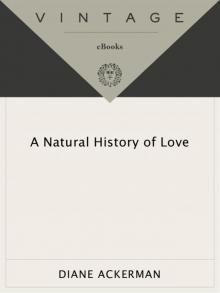 A Natural History of Love
A Natural History of Love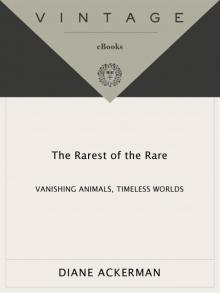 The Rarest of the Rare: Vanishing Animals, Timeless Worlds
The Rarest of the Rare: Vanishing Animals, Timeless Worlds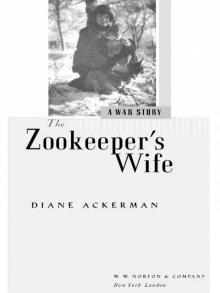 The Zookeeper's Wife: A War Story
The Zookeeper's Wife: A War Story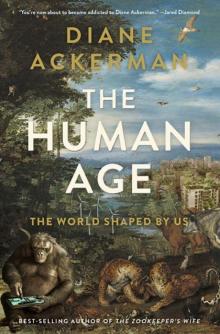 The Human Age: The World Shaped by Us
The Human Age: The World Shaped by Us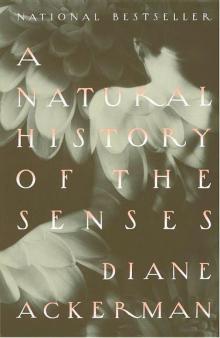 A Natural History of the Senses
A Natural History of the Senses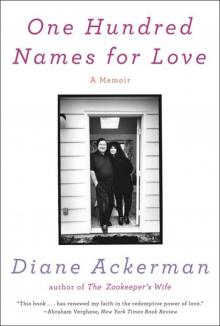 One Hundred Names for Love: A Memoir
One Hundred Names for Love: A Memoir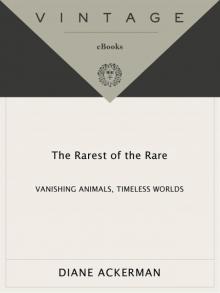 The Rarest of the Rare
The Rarest of the Rare